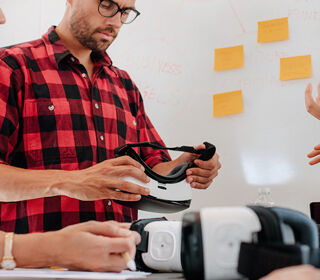
Blog

To the uninitiated, augmented reality (AR), virtual reality (VR) and mixed reality (MR) technologies might seem a little daunting and futuristic, but their implementation could be more imminent and accessible than you think. Having worked in multimedia since 1992 and early virtual reality since 1998, Professor Cham Athwal, Head of Research in the School of Computing and Digital Media Technology at Birmingham City University has watched the technology mature and become a sophisticated tool to enhance research and drive innovation.
During my time as a researcher and a lecturer at Birmingham City University, I have been fortunate enough to be involved in many ground-breaking projects and contributed to new findings, technologies and innovations, particularly in the health and manufacturing sectors. There are so many practical business and societal applications and companies should be investigating these boundless possibilities as a basis for future innovation. This blog will explore just a handful of inspiring examples to demonstrate the real-world impact these technologies can have on business and society, and how you can collaborate with Birmingham City University to access specialist knowledge for your business.
AR, VR and MR – What are they and how do they differ?
AR, VR and MR are technically three different disciplines, but I view AR and MR as very similar concepts. Virtual reality allows you to immerse yourself and explore a totally different environment using a helmet or ‘cave system’, which shuts away the outside world. The laws of physics don’t need to apply, meaning you can fly or have super powers.
The majority of my work has been in AR. In this case, you would typically be in a real life environment with some means of being able to see virtual content. Your phone is a simple example of this; you can view the world around you through the camera and virtual objects will appear on the screen, as though part of the scene you’re viewing. Phones and tablets are handheld and can be a clumsy experience, but a number of more sophisticated devices have been developed, like the Microsoft HoloLens or other head mounted devices with visors that allow you to see through whilst also displaying virtual objects on the screen. It uses a camera and other sensors to capture the real world and uses that to work out where to place other objects.
Applications to drive innovation in manufacturing and health
Businesses and organisations interested in taking advantage of AR and VR applications can collaborate with the university to benefit and learn from my experience and that of my team. Here are just some examples of the real-world applications that Birmingham City University can help you to implement.
Boosting productivity and training the workforce
A simple yet powerful application of AR is the training and supporting of workers in new processes and maintenance. Manufacturers need more flexible production lines to respond to requirements or customise products very quickly. AR helmets can help workers complete tasks effectively without long training processes. When fixing a machine an AR helmet can show employees the parts of the machine that need addressing and display virtual imagery to identify the correct parts and provide instructions through a microphone or sensory speakers, or by displaying text boxes. This technology is being considered by an automotive manufacturer as they attempt to move towards producing electric vehicles on the same product lines as their diesel and petrol engines. These innovative AR helmets will allow production staff to be able to switch quickly between the different types of powertrain they’re building on the same assembly lines; helping JLR to boost productivity and thrive competitively with a fast and flexible workforce.
Driving quick customisation and reducing costs
AR can also be applied to aid the smooth implementation of new parts and components in a manufacturing production line to visualise different components and designs on a physical product. Using AR, production staff can fit a virtual object before the design has been finalised, allowing them to test a new headlamp design on a car, for example, before investing in expensive equipment.
This can have a powerful application in marketing products too. We recently collaborated with local media production company, Holosphere VR. They had an electric bike prototype and by using AR and projecting different components and designs onto it, they were able to quickly customise it to a customer’s liking.
Applications for health innovation
Haptic systems
I’ve worked in virtual reality applications since 1998 and worked on an innovative project with Kings College Dental School that developed haptic training systems to allow dental students to practice drilling without causing lots of pain or damage. The VR system allowed students to see inside a virtual mouth and drill with an artificial device which would give force feedback to provide a similar experience to drilling an actual tooth. This drove ground-breaking changes in the way first year students were trained and a whole lab were set up using our systems. Our initial innovation has since been developed and more widely adopted to the extent that similar products are now produced and used commercially.
Enhancing medical consultations
AR and MR systems are applied in healthcare to an advanced level; they can be used to overlay the positions of a patient’s organs on top of their body. This can even be coalesced with an MRI or CT scan to calculate the size of their organs and give an accurate internal view without having to operate. I have recently been developing this technology to drive even more enhanced consultations. For example, a patient having a knee operation would have an MRI and CT scan to create a 3D model of the knee. AR allows internal anatomy to be exposed and manipulated as if there was a part of your body floating in front of you, allowing the surgeon to manipulate the image to demonstrate and explain accordingly.
Shopper science labs
We’re starting a Knowledge Transfer Partnership with a pharmaceutical company to develop their virtual pharmacy shopping experience to test and identify the most effective types of packaging. Through a collaborative project, they’re hoping to use our technologies to explore how customers interact with products on the shop floor. AR will enable them to try out variations in a faster and more cost-efficient way, whilst being able to monitor customer behaviour and adapt packaging accordingly at the design stage.
Drive innovation with a BCU collaboration
These technologies have so much untapped potential, and at Birmingham City University we’re excited to collaborate with businesses, organisation and developers to build upon our research and push boundaries in areas that offer real world or societal impact.
We invite enquiries for collaborations from manufacturing, entertainment and museum industries, as well as healthcare organisations. We’re simultaneously looking to extend AR’s capabilities in a wider business context, so we’d also like to talk to any developers of AR devices and other innovative companies striving to enhance the technology beyond what it is at present.

